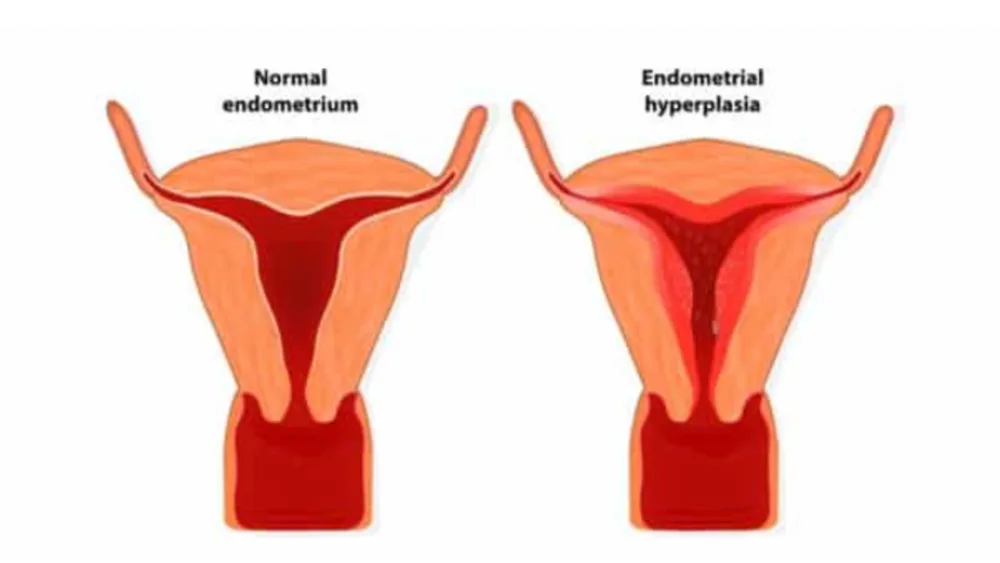Nowadays, more women are experiencing physical abnormalities that affect fertility, such as irregular menstruation, increasing age, environmental factors, and diet. Therefore, in addition to maintaining good health, observing one's own abnormalities and having regular health checkups can help prevent serious diseases and reduce infertility. One condition that women should be aware of and understand is abnormal thickening of the endometrium (uterine lining), which can cause infertility. If left untreated, this condition may become chronic and could potentially lead to endometrial cancer.

What is abnormal thickening of the endometrium?
Normally, a uterine lining (endometrium) that is 8 millimeters or more thick increases the chances of successful embryo implantation. However, it should not exceed 14 millimeters, as an excessively thick uterine lining can lead to infertility. The thickness of the uterine lining is primarily influenced by the hormone estrogen, which promotes the growth of the endometrium. After ovulation, the body produces progesterone—also known as the pregnancy hormone—which helps the endometrium mature and prepare for embryo implantation.
If fertilization does not occur, both estrogen and progesterone levels gradually decline, and the endometrial lining sheds through the uterus as menstrual blood. However, in cases of abnormal ovulation or lack of ovulation, the body produces only estrogen and not progesterone, which is necessary for maturing the uterine lining. This causes the endometrium to continue thickening without proper shedding, leading to abnormal thickening and possibly irregular bleeding.
Symptoms to Watch For
- Menstruation absent for 3–4 months, followed by unusually heavy bleeding when it does occur
- Menstrual cycles shorter than 28 days
- Spotting or light bleeding between periods
- Weight gain, oily skin, acne
- Increased body hair, reduced breast size, or a deeper voice
- Menstrual cramps – this may occur in some individuals due to endometriosis. If the endometrial tissue grows in the ovaries, it can lead to a chocolate cyst. If it grows in the uterine muscles, it can cause the uterus to thicken and become rounded. These conditions can present symptoms similar to or occur alongside abnormal endometrial thickening.
Therefore, it’s essential to consult a gynecologist for a pelvic exam and ultrasound to determine the exact cause. Even if you don’t have these symptoms but are concerned, you can visit a gynecologist for an early checkup.
Testing for Abnormal Thickening of the Uterine Lining
This condition can be diagnosed by consulting a gynecologist at a hospital. The doctor will ask about your symptoms, any abnormalities, and your medical history. An ultrasound will be performed to check the thickness of the uterine lining.
If there is abnormal vaginal bleeding, the doctor may perform additional tests such as a biopsy (tissue sampling), dilation and curettage (D&C) to collect samples for analysis, and hysteroscopy (using a scope to examine the inside of the uterus).
If any abnormalities are found during the examination, the doctor will provide personalized recommendations for treatment.
What causes this condition?
The main factors causing this disease are obesity, diabetes, irregular menstruation, or polycystic ovary syndrome (PCOS). Abnormal thickening of the uterine lining often occurs in women who are approaching menopause or are postmenopausal, especially those over 35 years old, who have a higher risk of developing this condition. However, women of any age can also be affected.
If left untreated, this condition can lead to cancer.
Abnormal thickening of the uterine lining not only causes infertility but also carries a risk of developing cancer, especially in women with high-risk factors such as irregular menstruation, obesity, or diabetes. These women should undergo thorough physical examinations and have uterine lining cells sampled for detailed analysis. Early detection of abnormal cell growth or cancerous cells allows for timely treatment.
Early diagnosis and treatment can lead to a cure.
Abnormal thickening of the uterine lining is one cause of infertility because it often results in irregular or absent ovulation, making fertilization difficult. Even if fertilization occurs, the uterine lining may not be healthy enough to support embryo implantation. Therefore, if you experience any abnormal symptoms, it is best to get examined and treated promptly for a better chance of recovery.
Message for all women:
“Women should pay special attention to their menstrual cycles and observe if their periods are regular. If they become irregular or are accompanied by other symptoms like increased body hair, acne, or oily skin, it’s important to get checked for polycystic ovary syndrome (PCOS). This condition can lead to various complications, including infertility and abnormal thickening of the uterine lining, which if left untreated for a long time, may increase the risk of cancer. Some women experience heavy bleeding after missing several periods, which can lead to severe blood loss.”
Finally, abnormal thickening of the uterine lining can recur, especially if you don’t exercise and maintain a healthy weight.
If you are concerned, you can consult with Beyond IVF or add Line @beyondivf for more information.






